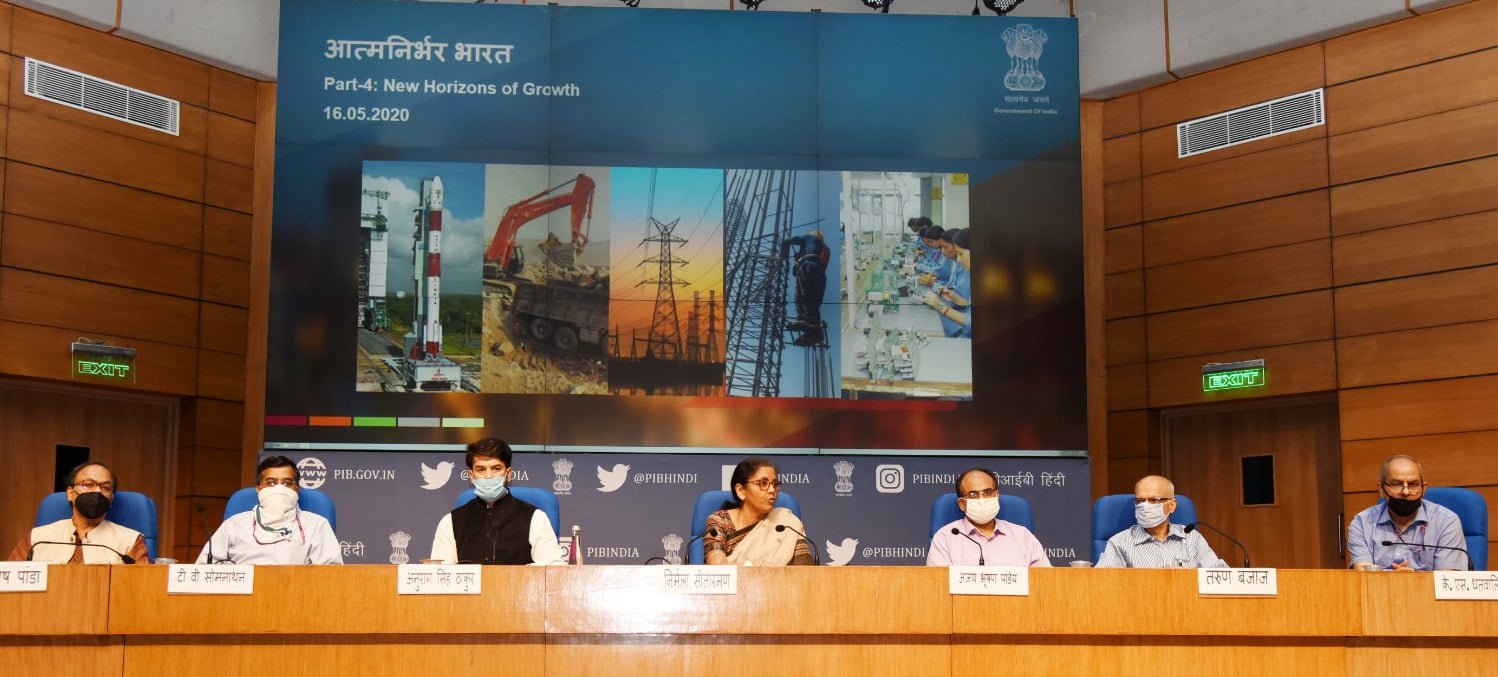Social infra: Rs.81,000 crore
Finance Minister Nirmala Sitharaman has announced new horizons of growth, structural reforms across eight sectors on 16 May 2020 as part of the economic revival measures.
KEY HIGHLIGHTS:
Commercial Mining introduced in Coal Sector
Diversified Opportunities in Coal Sector
Liberalised Regime in Coal Sector
Enhancing Private Investments and Policy Reforms in Mineral Sector
Enhancing Self Reliance in Defence Production
Policy Reforms in Defence Production
Efficient Airspace Management for Civil Aviation
More World-Class Airports through PPP
India to become a global hub for Aircraft Maintenance, Repair and Overhaul (MRO)
Tariff Policy Reform in Power Sector; Privatization of Distribution in UTs
Boosting private sector investment through revamped Viability Gap Funding Scheme in Social Sector
Boosting private participation in space activities
Reforms in Atomic Energy Sector
Sitharaman said that many sectors need policy simplification, to make it simpler for people to understand what sector can give, participate in activities and bring transparency.
“Once we decongest the sectors, we can boost the sector, for growth,” the Finance Minister assured.
Sitharaman outlined the need for Policy reforms to fast track investments and the steps taken by the Government in this regard.
Fast track clearance is being done through Empowered Group of Secretaries, a Project Development Cell would be set up in each Ministry to prepare investable projects and coordinate with investors and Central and State governments.
The Finance Minister announced policy reforms to fast track investment.
There will be ranking of States on investment attractiveness to compete for new investment.
Incentive schemes for promotion of new champion sectors will be launched in sectors such as solar PV manufacturing; advanced cell battery storage etc.
Sitharaman also announced that a scheme will be implemented in States through challenge mode for Industrial Cluster Upgradation of common infrastructure facilities and connectivity.
There will be availability of industrial land/land banks for promoting new investments and making information available on Industrial Information System (IIS) with GIS mapping. 3376 Industrial Parks/ Estates/SEZs in five lakh hectares are mapped on IIS. All Industrial Parks will be ranked during 2020-21.
The Finance Minister said structural reforms in the eight sectors of Coal, Minerals, Defence production, Civil Aviation, Power Sector, Social Infrastructure, Space and Atomic energy.
The details are as follows:
A. COAL SECTOR
The Government will introduce competition, transparency and private sector participation in the Coal Sector through:
A revenue sharing mechanism instead of regime of fixed Rupee/tonne. Any party can bid for a coal block and sell in the open market.
Entry norms will be liberalised.
Nearly 50 Blocks will be offered immediately. There will not be any eligibility conditions, only upfront payment with a ceiling will be provided.
There will be exploration-cum-production regime for partially explored blocks against earlier provision of auction of fully explored coal blocks. This will allow private sector participation in exploration.
Production earlier than scheduled will be incentivized through rebate in revenue-share.
Diversified Opportunities in Coal Sector
Coal Gasification/Liquefication will be incentivised through rebate in revenue share. This will result in significantly lower environment impact and also assist India in switching to a gas-based economy.
Infrastructure development of Rs.50,000 crore will be done for evacuation of enhanced Coal India Limited’s (CIL) target of one billion tons coal production by 2023-24 plus coal production from private blocks. This will include Rs.18,000 crore worth of investment in mechanised transfer of coal (conveyor belts) from mines to railway sidings. This measure will also help reduce environmental impact.
Liberalised Regime in Coal Sector
Coal Bed Methane (CBM) extraction rights will be auctioned from Coal India Limited’s (CIL) coal mines.
Ease of Doing Business measures, such as Mining Plan simplification, will be taken. This will allow for automatic 40% increase in annual production.
Concessions in commercial terms given to CIL’s consumers (relief worth Rs 5,000 crore offered). Reserve price in auctions for non-power consumers reduced, credit terms eased, and lifting period has been enhanced.
MINERAL SECTOR
Enhancing Private Investments in the Mineral Sector
There will be structural reforms to boost growth, employment and bring state-of-the-art technology especially in exploration through:
Introduction of a seamless composite exploration-cum-mining-cum-production regime.
500 mining blocks would be offered through an open and transparent auction process.
Joint Auction of Bauxite and Coal mineral blocks to enhance Aluminum Industry’s competitiveness will be introduced to help Aluminum industry reduce electricity costs.
Policy reforms in Mineral Sector
The distinction between captive and non-captive mines to allow transfer of mining leases and sale of surplus unused minerals, leading to better efficiency in mining and production shall be removed. Ministry of Mines is in the process of developing a Mineral Index for different minerals.
There will be rationalisation of stamp duty payable at the time of award of mining leases.
DEFENCE SECTOR
Enhancing Self Reliance in Defence Production
‘Make in India’ for Self-Reliance in Defence Production will be promoted by notifying a list of weapons/platforms for ban on import with year wise timelines, Indigenisation of imported spares, and separate budget provisioning for domestic capital procurement. This will help reduce huge Defence import bill.
Improve autonomy, accountability and efficiency in Ordnance Supplies by Corporatisation of Ordnance Factory Board.
Policy Reforms in Defence Production
FDI limit in the Defence manufacturing under automatic route will be raised from 49% to 74%.
There will be time-bound defence procurement process and faster decision making will be ushered in by setting up of a Project Management Unit (PMU) to support contract management; Realistic setting of General Staff Qualitative Requirements (GSQRs) of weapons/platforms and overhauling Trial and Testing procedures.
CIVIL AVIATION SECTOR
Efficient Airspace Management for Civil Aviation
Restrictions on utilisation of the Indian Air Space will be eased so that civilian flying becomes more efficient. This will bring a total benefit of about Rs 1,000 crore per year for the aviation sector. This will lead to optimal utilization of airspace; reduction in fuel use, time and will have positive environmental impact.
More World-Class Airports through PPP
Six more airports have been identified for 2nd round bidding for Operation and Maintenance on Public-Private Partnership (PPP) basis.
Additional Investment by private players in 12 airports in 1st and 2nd rounds is expected to bring around Rs.13,000 crore. Another six airports will be put out for the third round of bidding.
India to become a global hub for Aircraft Maintenance, Repair and Overhaul (MRO)
Tax regime for MRO ecosystem has been rationalized. Aircraft component repairs and airframe maintenance to increase from Rs.800 crore to Rs.2,000 crore in three years.
It is expected that major engine manufacturers in the world would set up engine repair facilities in India in the coming year.
Convergence between Defence sector and the civil MROs will be established to create economies of scale. This will lead to maintenance cost of airlines to come down.
POWER SECTOR
Tariff Policy Reform
Tariff Policy laying out the following reforms will be released:
Consumer Rights
DISCOM inefficiencies not to burden consumers
Standards of Service and associated penalties for DISCOMs
DISCOMs to ensure adequate power; load-shedding to be penalized
Promote Industry
Progressive reduction in cross subsidies
Time bound grant of open access
Generation and transmission project developers to be selected competitively
Sustainability of Sector
No Regulatory Assets
Timely payment of Gencos
DBT for subsidy; Smart prepaid meters
Privatization of Distribution in UTs
Power Departments/Utilities in Union Territories will be privatised. This will lead to better service to consumers and improvement in operational and financial efficiency in Distribution. This will also provide a model for emulation by other Utilities across the country.
Social Infrastructure:
The Government will enhance the quantum of Viability Gap Funding (VGF) up to 30% each of Total Project Cost as VGF by the Centre and State/Statutory Bodies. For other sectors, VGF existing support of 20% each from Government and States/Statutory Bodies shall continue.
Total outlay is Rs.8,100 crore. Projects shall be proposed by Central Ministries/State Government/Statutory entities.
SPACE SECTOR:
There shall be level playing field provided to private companies in satellites, launches and space-based services. Predictable policy and regulatory environment to private players will be provided. Private sector will be allowed to use ISRO facilities and other relevant assets to improve their capacities.
Future projects for planetary exploration, outer space travel among others shall also be open for private sector. There will be liberal geo-spatial data policy for providing remote-sensing data to tech-entrepreneurs.
ATOMIC ENERGY RELATED REFORMS:
Research reactor in PPP mode for production of medical isotopes shall be established to promote welfare of humanity through affordable treatment for cancer and other diseases.
Facilities in PPP mode to use irradiation technology for food preservation – to compliment agricultural reforms and assist farmers shall also be established. India’s robust start-up ecosystem will be linked to nuclear sector and for this, Technology Development-cum-Incubation Centres will be set up for fostering synergy between research facilities and tech-entrepreneurs. fiinews.com









